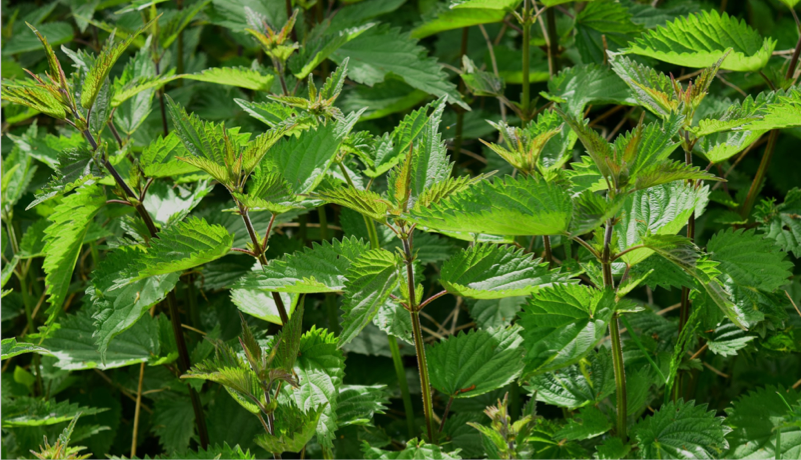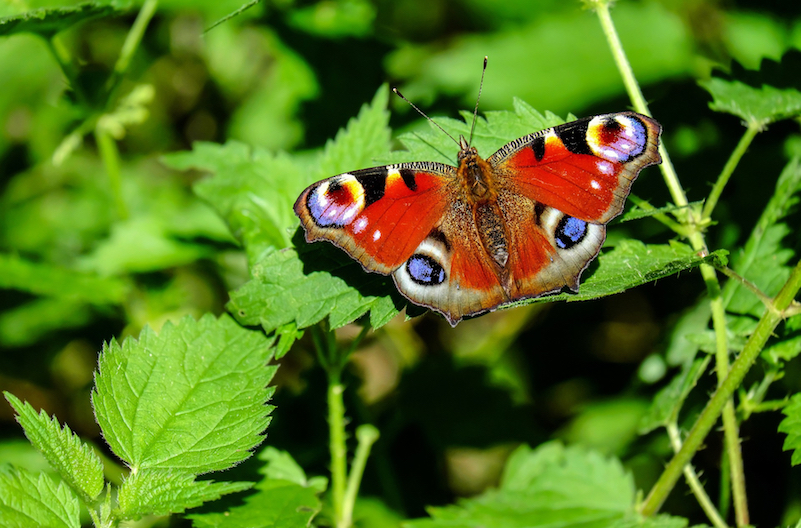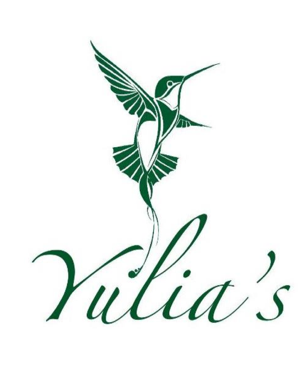Your cart is currently empty!

Nettle.
Stinging nettle.
Why does it sting? Is it to protect itself from herbivores, or may be to serve humans?
Here in Northern Wisconsin May, early June (before blooming actually) is a perfect time to collect nettles. When I pick them barehanded, I don’t mind an occasional sting, it feels good, it feels medicinal. In fact some people use the “urtication” method, when they deliberately whip themselves with nettle plant to achieve therapeutic effects. The blood circulation increases and becomes more efficient. Stagnation goes away and toxins get cleaned out faster. It is especially great for joints, backs and numb muscles.
So what exactly stings?
The stem and underside of the leaves are covered in tiny long sharp, hollow hairs, or silica needles (they are made of glass for real). When you brush against them, they break, pierce thin clothing or skin and inject the juice. The juice is primarily formic acid (the same that ants have, lemony flavored), histamines and B4 vitamin. It can cause temporary irritation, and is generally very safe. On very rare occasions some people show allergic reactions.
How to safely collect nettles
If you are new to nettles, I would recommend using cloth or leather gloves for collecting. In young specimens I cut the stem off below the low leaves and use the whole thing for eating. My favorite way to prepare them this year is to heat up some olive oil, throw nettle bunches in to a pan, and stir fry for a couple minutes. The sting goes away, the leaves brown and toast. Those things taste amazing! You can eat them straight, as a side dish, wrap them in tortilla with scrambled egg, cooked hamburger, and cheese.
Why is it a good idea to eat nettles?
Nettles have a long tradition of use as food and nutrition. Every spring my mom and I collected nettles for soup. We just mixed onions, carrots, potatoes, boiled egg and nettles. Delicious! Full of chlorophyll, they build up and cleanse your blood, enriching it with vitamins A, C, iron, potassium, calcium and manganese.
If you have low blood iron, try nettle tea. 2-3 weeks and you will have more energy.
In Ancient Greece they were used on sores and cuts, helping them to heal quicker. Julius Caesar’s soldiers whipped each other with nettles for warming up.
Nettle wine is made in England, and they even have a competition on who will eat the most of raw nettles. Those British are so tough!
Drink your tea!
Nettles work with metabolic disorders, when metabolism is mixed up, in cases of allergies, arthritis and gout. It is my favorite for seasonal allergies.
One time some years ago I was drinking nettle tea for three weeks or so, and was very surprised when kidney stone came out! I did not even know I had a kidney stone (all that hard city water in Russia while growing up!) This kidneys’ friend, besides being a blood cleanser, is also restoring and nourishing (eczema cases).
Sauna nettle massage
Nettles are used in saunas, where the bundle whips the body parts. We have a saying in Russia, “you come out of the sauna, and you are newly born again” ! Well, nettles will really clean your skin and blood externally too! Interestingly, if a person gets red skin and itches from this massage, it is an indication that he/she needs more vitamins. If not, the balance of vitamins is OK.
Nettles for hair
I make nettle bar shampoo, because the nettles are excellent for hair due to their high silica content. You can just brew up some tea from your patch and rinse your hair. I know this one Russian girl with amazingly long, thick (to her ankles) hair. Twice a week for years her mom was rinsing her hair with nettles and burdock. If you have any trouble with hair health, hair loss, give the nettles a try!
Nettle folklore
Growing up in Russia we dared and pushed each other in to the nettle patch for a “swim”. My boys sting their hands and watch the blisters raise on their skin:-)
In Germany the phrase “to sit in nettles” means to get into trouble. In France they say: “Do not push grandma into the nettles” if you don’t want to make matters worse.
People have wrapped meat and fish in nettle leaves for successful food preservation. In England this one kind of cheese is wrapped in nettle leaves to achieve a special flavor during cheese aging process.
Green eggs and ham for real?
People have been feeding their cows, goats, pigs and chickens the dried nettles. They are up to 25% protein, very nutritious and similar to alfalfa hay. If you feed your laying hens enough nettles (6.5 grams per 2 pounds of feed), they say it is possible to achieve GREEN egg yolk. Anyone wants to try this?
Where would you find this green magic?
It likes areas of high fertility with disturbed (walked on or tilled) soil, rich in nitrogen and phosphate. A little wetness is good, also look for it on the edge of the forest or field or in the meadows.
Nettle textile
For 2000 years humans made bags, clothes, ship sails, rugs and ropes with nettle fiber. It is very similar to flax, but smoother. Nowadays you can order nettle fabric or yarn even on Etsy.
And in Russia they are selling nettle socks and people swear their feet and legs don’t ache…
G.H. Andersen wrote an inspiring story called Wild Swans, where this girl needs to save her 11 brothers from the evil witch by knitting 11 sweaters using yarn from the stinging nettle fibers.
Germans at one point in WW1 switched to nettle fiber for their uniforms, because of lack of cotton at the time. Nettles grow wild and are prolific in any weather and don’t require pesticides like cotton. May be just a thought for the future?
So if you would like to try working with it, search online for Nettles For Textiles and you will find great videos on how to process this weed and get it to the yarn stage.
By the way, the roots are used as a yellow dye, and leaves as a green. Sometimes I dye my eggs green for Easter using strong nettle solution with a little vinegar.
Butterfly food
Some butterflies use nettles for food. Red Admiral and beautiful Peacock eyes. The latter one, I only spotted in Russia, it is so beautiful.

You can find nettle & henna shampoo and organic nettle tea on my website at www.yulias.net or call 715-798-3175

Leave a Reply